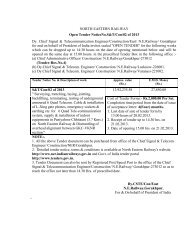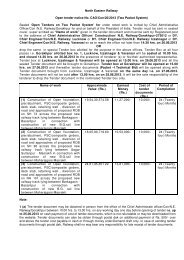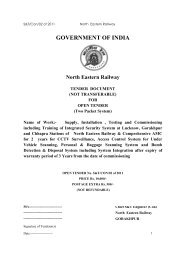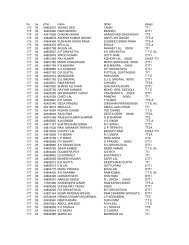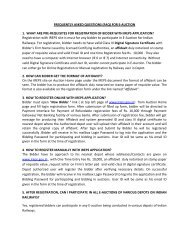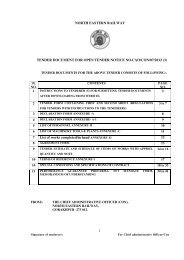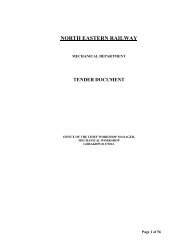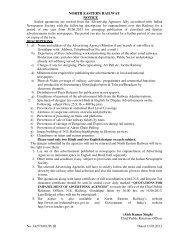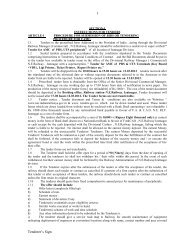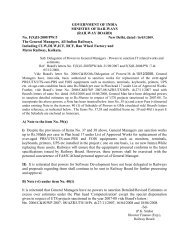GOVERNMENT OF INDIA North Eastern Railway ... - Tenders India
GOVERNMENT OF INDIA North Eastern Railway ... - Tenders India
GOVERNMENT OF INDIA North Eastern Railway ... - Tenders India
You also want an ePaper? Increase the reach of your titles
YUMPU automatically turns print PDFs into web optimized ePapers that Google loves.
Dy.CSTE/Con/ IZN/02 of 2011 <strong>North</strong> <strong>Eastern</strong> <strong>Railway</strong><br />
When a cable has to be taken and terminated on the Ist. floor cabin it shall be first led<br />
inside the ground floor of the cabin by cutting the masonary structure of the wall of the<br />
cabin and then it will be taken through a HDPE pipe fixed vertically on the inside of the<br />
cabin wall by suitably clamps to be embodied on the wall as per arrangement shown in<br />
Drg.No. CSTE/ CON / <strong>OF</strong>C – 1/2004.<br />
3.9 LAYING <strong>OF</strong> CABLE IN SPECIAL CASES<br />
3.9.1 NEAR POWER CABLE :When the contractor comes across any other cable already<br />
laid, he shall first report the fact to the engineer .& cable should be identified by<br />
the Engineer as a power cable (LT or HT). the trench shall be dug as far away from the<br />
route of the power cable as practicable.<br />
3.9.2 CROSSING <strong>OF</strong> TLECOMMUNICATION CABLE WITH ANOTHER CABLE: Crossing<br />
of the telecommunication cable with another cable shall be avoided wherever<br />
possible. Where however, this is not possible, the telecommunication cable shall be<br />
laid in cement or asbestos cement pipes. The length of pipe of to be provided on either<br />
side of the crossing shall be at least one meter.<br />
3.9.3 LAYING <strong>OF</strong> OTHER THAN TELECOM. CABLE IN THE SAME TRENCH<br />
No other cable shall be laid in the trench for the telecommunication cable. Where,<br />
however, exceptional circumstance exits, the telecommunication cable may be laid<br />
along with another cable in the same trench provided a specific permission of each<br />
such case is obtained in writing from Engineer. When telecommunication cable and<br />
L.T power cable/ Signalling cable have to be laid in the same trench they shall be<br />
separated by placing a layer of brick between them vertically (approx. 16 bricks/<br />
meter) or laid in HDPE pipe.<br />
3.9.4 LAYING <strong>OF</strong> CABLE THROUGH PIPES.<br />
i) The cable shall be laid through G.I./HDPE pipes at the locations marked on the<br />
tapping and route plan and as advised by the Engineer or his representative.<br />
ii) Laying the cable through pipes galvanized steel wires of a cross section not less<br />
than 10 SWG shall be used as a lead wire. Two such lengths of wires shall be<br />
laid through the pipes, so that after the cable is threaded through the pipe, one<br />
lead wire is permanently left in the pipe with a suitable overlay at two ends, to<br />
eagle the cable to be pulled out at a later stage if required to do so.<br />
iii) On arch bridges and culverts bridges the cables will be threaded through<br />
GI/HDPE pipes etc. while threading the cable through these pipes the<br />
contractor shall do the trenching to the required depth wherever necessary for<br />
which no extra charge will be paid.<br />
LAYING NEAR OILY SURFACE. If during the excavation of trenches for laying<br />
cables the contractor or his representative notices the presence or oil or oily substance or any<br />
other chemical which is likely to cause the deterioration of the cable protective material he<br />
shall bring the matter to the notice of the engineer or his representative and on the latter's<br />
decision he shall choose an alternative cable route or he shall protect the cable in such places<br />
in such a manner as advised in writing by the engineer or his representative. No additional<br />
charges are payable.<br />
Signature of Tenderer(s)<br />
Date…………………<br />
46



